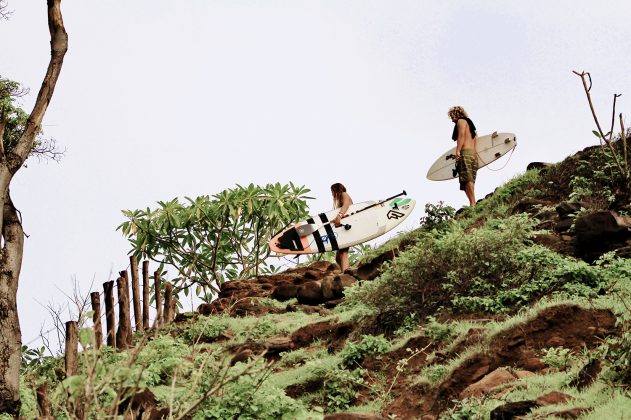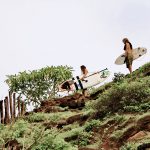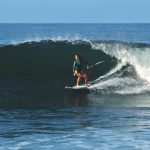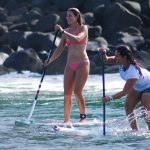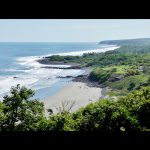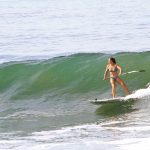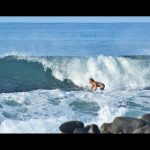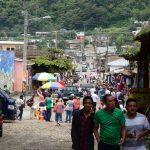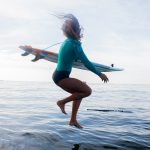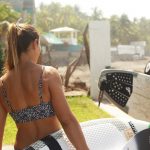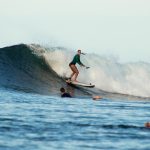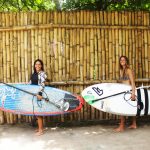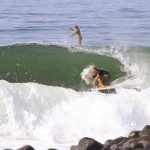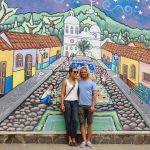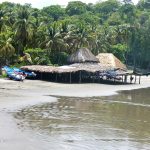EL SALVADOR
Words María Andrés // Photos Pablo Morataya, Rogelio Alexander Arébalo, Samuel Rivera
The past few years, I’ve travelled the world in search of stunning beaches, beauty, adventure, and incredible waves. This year, I told myself that I would also plan my trip with a conscious effort to improve my performance on the wave, to visit a spot that would allow me to practice my surfing every single day. The requirements were simple: warm water, and consistent, quality waves, and an interesting new country to discover.
SUP surfing is a difficult sport, and without the opportunity to spend enough hours in the water day-in-day-out over the span of a few weeks at a time, it is nearly impossible to improve. After a few hours of research, Tom and I stumbled upon El Salvador as a destination that would allow me to improve my level in the water, while exploring a new country and culture that I was not familiar with.
Volcanic Landscapes
Nestled between Guatemala and Nicaragua, on the Pacific coast of Central America, El Salvador’s coastline is a thing of beauty for a surfer. Offering plenty of southern exposure, its volcanic geology has created a bounty of world-class right-hand point breaks that dot its 300km of coastline.
I must admit, prior to booking my trip I hadn’t really heard much of El Salvador, and wouldn’t have been able to pin it on a map. Little did I know, I have been dreaming about these lands since I was a child, as its stunning landscape and volcanoes were the inspiration for the Prince´s planet in Saint-Exupéry’s classic “The Little Prince”.
The country’s geological activity was apparent throughout the entire trip. Views of beautiful volcanoes abound, and are constantly visible from every vantage point. It was possible to see smoke escaping from some of the still active volcanoes, a few of which even acted as lighthouses and were used for naval navigation in years past. I highly recommend visiting some of the natural hot springs bubbling up out of the volcanoes as well, to relax the muscles after a week of SUPing. We were also taking advantage of this geologic activity on an everyday basis, as much of the country’s power is generated by geothermal activity.
El Salvador’s rough landscape has also played a difficult role in the country’s past. Very little colonial architecture has survived the seismic activities of the last centuries. However, its volcanic eruptions have also miraculously preserved some ancient Mayan ruins in a Salvadorian version of Pompeii, which can be visited at Joya de Cerén, a UNESCO World Heritage Site. When discovered, it was the first Mayan archeological site of a village, where it is possible to see a glimpse of everyday life, as opposed to temples which were the only other Mayan remains discovered until then.
Violent Past
Many tourists traveling through Central America tend to avoid El Salvador, due in part to its reputation for its violent history from the civil war that erupted in the country in the 1980s and early 1990s. Although it is now in a time of peace, relics of the war are visible to this day, with bullet holes and explosion sites in buildings throughout the country. It is also felt when you notice the presence of armed security guards at every parking lot, grocery store, and bank, something that is alarming to visitors, yet considered as synonymous with security and a part of everyday life for the Salvadorans.
Memories of the civil war are still fresh in the minds of Salvadoran people, who are very proud to be living in this time of peace and prosperity, and are excited to share their country today after enduring such a violent past. The hashtag #dontskipelsalvador invites tourists to discover everything that the country has to offer.
Those that do visit are treated not only to its bounty of waves, but also to its rich archaeological history, colourful towns and villages countryside, artisanal craft and art, bustling markets, and a chance to discover its friendly population.
Among the various touristic trips that are offered in El Salvador, one of the most popular is the Ruta de la Paz (Route of Peace), a visit through the war-torn countrysides, jungles, and towns, guided by former guerilla warriors who offer a first-hand account of their own personal histories fighting for peace.
World-Class Waves / La Libertad
El Salvador’s 300km may be short, but its southern orientation means the country is peppered with world-class point breaks. The famed Punta Roca is host to many international surf competitions, and it’s many other waves draw North American and South American surfers looking to escape the crowds of nearby Costa Rica and Nicaragua.
At the heart of the La Libertad region is El Tunco, the country’s surfing hotspot, and home to the extremely consistent wave of El Sunzal. Arriving in El Tunco, my first impression was of a typical backpacker/party/surf town, with pumping music on the beach and the cerveza freely flowing at all times of day. This was a marked contrast to the perfect, glassy, right-hand peelers, a dream setup for longboarders and SUP surfers. We quickly discovered that the best place to be was in the water.
Although we were not big fans of El Tunco itself, its location is central to a myriad of waves dotting the coastline. Hopping on a “Chicken Bus” with board in hand, there was a wide variety of waves within a quick 5-10 minute ride. The buses are converted yellow school buses, each distinctly painted in bright colours, with pumping music and always crowded with people and animals. We eventually learned that hitch-hiking and hopping into the back of a pick-up truck was a common practice among locals, and that it is an even better way to get around.
As we got to know the other beaches around the Tunco area, we were intrigued to see that almost all Salvadorans would enter the ocean fully dressed, no matter their age. Long shorts that go past the knees paired with an oversized t-shirt was the most common beach attire. No bikinis to be found here. This came as a complete shock considering the temperatures in this tropical country, and a stark contrast to what we expected from a Latin American beach scene. As we eventually learned, El Salvador’s Catholic history plays a very strong role in today’s culture, which explains why a bikini or board shorts were almost unheard of outside of the more touristic El Tunco beach.
The Wild East
Having visited many countries with my SUP, and knowing the reputation of our sport as not always being welcomed at every wave, the first thing I did before we flew down to El Salvador was get in touch with a local SUP surfer, to get some insider information as to which waves are a no-go, and where we would feel most comfortable. This is how we met Josselyn Alabi, the top female SUP surfer in the country. She welcomed us in her country with open arms, and was our local guide to the spots around La Libertad. After a week of surfing in La Libertad, and with talks of a monster swell on the horizon, we decided it was time to pack up in search of new waves. At 6am, the boards were strapped to the roof, and together with Josselyn we were headed toward the “Oriente Salvaje”, the Wild East. When looking at a map of Central America, the Gulf of Fonseca is what separates El Salvador from Nicaragua, together with Honduras on the inside of the gulf. We heard whispers of a secret wave that forms only when a huge south swell wraps around into the Gulf. This is where we were headed. One of the peculiarities of waves on the Gulf of Fonseca is that it is not a dawn-patrol type of spot, as the waves are usually blown out by the Papagayo winds that blow in over Lake Nicaragua, and usually drop off in the early afternoon to stay glassy the rest of the day. As we were travelling with our windsurf sails as well, these winds were an extra motivation to check out the spot.
Finding the Waves
As often happens with our sport, frustration manifests itself in different ways. Not only when you don’t catch waves, but also when you don’t find them. The “mystical wave” turned out to be a messy knee-high break. As we waited it out to see whether the swell would eventually build, after a few hours it was decided to cut our losses and head to the more exposed waves around El Cuco, about 45 minutes to the west.
Pulling up to Las Flores, it was clear that here the swell had arrived. What lay before our eyes was a natural wonder; a perfect right-hand point break, walling up and barreling over a volcanic-sand bottom, set in the most beautiful and photogenic shoreline imaginable. You know that feeling of being inside a movie? Or imagining yourself in the photos of a magazine? That is how we felt in Las Flores. It turns out that not only had the swell arrived here, but it had brought with it dozens of top-level surfers and photographers to tear up the endless walls and barrels that were constantly marching in. It was a true show of human vs nature. I didn’t dare enter the water for the first two days, and my frustrations grew as the massive waves kept rolling in and I was unable to take advantage of them.
Eventually, as the swell started to fade, and taking with it the crowds, we were left to enjoy this beautiful spot with a perfect head-high wave walling up and peeling for over 300 meters. As we discovered, not all of the beaches of El Salvador’s “Wild East” are as remote and virgin as we had imagined. The hills around Las Flores are built up with houses and hotels. Fortunately, most of these are built with respect for the stunning landscapes that surround them, and do not give up on their surfing roots. This was evident at Las Flores Resort, a high-end hotel located directly in front of this perfect wave, which caters to a surfer’s every need. Board racks, boat trips to other nearby breaks, and even offering breakfast at 5am for those in need of some energy before heading out for a dawn patrol session.
On the other end of the scale, there are also rooms available for rent that are the equivalent to sleeping in a cement bunker directly on the beach. Worn out mattresses, barely a trickle of water coming out of the shower, and plenty of thirsty mosquitoes don’t deter many. After all, whether you’re staying in five-star luxury or at the surf-bum special, everybody gets to the ride the same perfect waves.
From frustration to Progress
Never had I improved so much, so quickly, as in Las Flores. After all the frustrations, trials, falling, giving up, fighting currents, exhaustion, combined with sleepless nights due to thirsty mosquitoes, the magic of learning after not having given up began to sparkle. As I became more comfortable in bigger waves, my confidence grew. I learned to trust my lungs. I learned that I can go when it’s big, and that my lungs resist more than I thought. I learned the timing necessary to avoid the impact zone when paddling out, and how to use the currents in my favour. I learned that everybody belongs in the water, and that even though I was on a SUP, with care and respect I earned my position in the lineup, as well as a few shouts from the surfers. Shouts of cheering and encouragement, that is. We began to transform our frustrations into the radiant energy of somebody that is achieving their goals. Without a doubt, our confidence was growing. After a few weeks of surfing and improving every day, it was time to leave Las Flores behind and head 30 minutes west to El Salvador’s most famous barrel, Punta Mango. Getting barreled is a big step up, but you have to start somewhere. Little by little, we began to take our first baby steps.
Barrels and Rocks. Getting in position.
With its difficult road access, Punta Mango is a much more remote beach than Las Flores. Most surfers arrive by boat, and only spend 2-3 hours in the water in the early mornings. It was common for us to have the wave to ourselves, sharing it with just a few local kids every day after the tourists had gone back for breakfast. The Rancho where we stayed was very “roots”, to say the least. Green, muddy, humid, and plenty of scorpions, snakes, and spiders. It was exactly what we were looking for. Making our way down the dewy cliff as the sun was rising, we would watch perfect empty waves down below. We looked each other smiling… This view was enough to keep us happy all day! It was here that I discovered that I needed to overcome another fear: the rocks. The drop is mere meters away from the barnacle covered rocks, and the wave broke heavily as it peaked.
Let’s just say, my fears were not unfounded. Eventually, with Tom’s help and patience, I began to position myself deeper and deeper. I was tired of missing waves by paddling on the shoulder, and learned that here it was all about commitment and confidence. There is a difference between knowing where to position yourself, and actually doing so. I learned to position myself according to the wave, and not to position myself according to other surfers in the water. This was a huge revelation for me, and dramatically increased my wave count going forward.
In this remote location, and without having brought a photographer, we hired some local kids to shoot photos of our early morning sessions. We may not have the best photos from these sessions, but it was a pleasure to work with and support these kids who are so motivated to learn and shoot the surfers. Waking up at 5 am every day, their dedication will soon pay off and we are sure some of them will one day become professional surf photographers. With the plan to head inland in a few days, we spent as much time as possible on the water before leaving the coast. A new swell was arriving, and we were surfing for 4-5 hours a day. We felt that were taking full advantage of our final days and were able to enjoy the fruits of all of the hard work and progress we had made over the last month.
Lessons Learned
We may not have managed to get barreled and come out standing, but there we were: well positioned, committing to steeper and later take-offs, and knowing when to abandon ship. Despite growing up on a board while windsurfing, I feel that in this month of SUP off the Central American coast, the ocean has taught me more than ever before.
I have felt incompetence, frustration, the force of the ocean not allowing me to enter or exit due to its currents, the nerves and fear of having so many people in the ocean around me, the incredible forces of the waves during a wipeout, and enduring the longest hold-downs of my life. I have felt all of these frustration convert themselves into courage, confidence, believing in myself, and wanting to give myself the opportunity to get better at what I love.
I have felt the tremendous satisfaction of overcoming these difficulties, the unexplainable euphoria of dropping in on a big wave, and a huge gratitude to my partner for motivating me and accompanying me through difficult moments in order to achieve this. Not only surfing, but in life in general, it is extremely frustrating when something you love to do seems out of reach. It produces so much anger and frustration, that if you don’t channel it correctly, you risk losing motivation for what you really want and love. Coming back from the water with tears in my eyes, or crying in bed after a bad day, seeking out the positives helps you become a stronger person and fighter. Once you achieve this, this satisfaction is limitless.
This time I didn’t manage to get barreled, but what I learned during this experience is that it may not have been this month, and it may not be the next, but what I do know is that the best wave is still out there.

